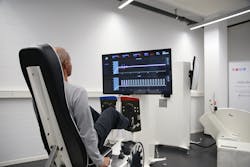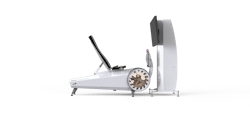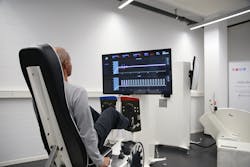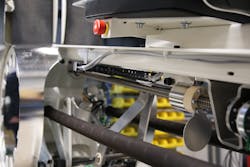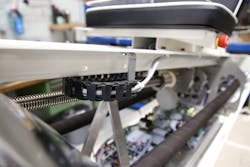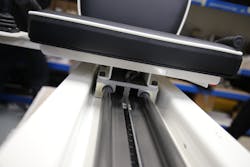Training Robots Deliver Health Assessment Metrics During Physical Rehabilitation
More and more, data is being collected to help evaluate health and sports performance. Now, robots are being used to help people of all abilities get insights into their health. And the wealth of information available is overwhelming.
Dynamic Devices AG of Switzerland has developed a robotic system that tracks, analyzes and visualizes the interaction of an individual’s central and peripheral nervous system with their lower extremities.
The original idea was to simulate the interaction of humans with their environment, according to Raja Dravid, chief business development officer of ddrobotec, which is the brand name of the product. “Eighty-year-old people can easily jump over a garden fence in our simulation; they can’t do that in the real world,” said Dravid.
The metrics provided by the system range across an impressive spectrum. The insights include average power, which is an indicator of vitality and peak performance. It is also a strong predictor of functional limitations. The system can also measure working memory, which is assessed by counting the longest list of items that a person can repeat back immediately after the presentation. It can also measure reaction time, a cognitive assessment that indicates how quickly a patient can respond to a visual signal when it appears.
In all, the system analyzes more than 50 digital biomarkers to determine an individual’s cognitive, motor, physical and physiological abilities. Insights from the data can allow anyone—from high performance athletes to patients recovering from medical procedures—to monitor recovery, make informed decisions and stay motivated during recovery while optimizing health and boosting performance. The company believes 99% of users can use insights from data to make improvements in training and rehabilitation.
READ MORE: The Need for Speed: Ergometers can Benefit from Lube-Free Bearings
Core Strength
The core of the training robot is a pneumatic muscle, which generates variable force and dynamics on the unit’s two pedals. High-precision sensors and real-time visual feedback enable accurate measure of coordination, strength, quickness and endurance.
Training takes place in a standardized environment where training intensity, duration and cognitive engagement are measured and analyzed. Control algorithms ensure smart load adaptation, individually, in real time and leg independent. The technology is adjustable and joint-friendly up to 2,700 Newtons per leg—more than 600 lb per leg—and offers benefit for up to almost everyone, from elementary age children to recovering hospital patients to Olympic athletes.
“Our systems motivate and engage the user far more comprehensively than traditional training devices,’’ Dravid said.
Changing to Plastic Bearings
Dravid said an important development in the design of the training robot was swapping out metal ball bearing guides and brass parts with components from igus, the German manufacturer of high-performance plastics.
“We were looking for a solution for our plain bearings—without oil and constant lubrication—because dirt, dust and grime were permanently collecting,” Dravid said.
While initially skeptical, tests confirmed they delivered the results Dravid was seeking. “We then replaced more and more plain bearings and nuts with igus components,” Dravid said. “This even went so far that we made design changes so that we could switch the entire bearing technology to igus products.”
Besides being lubrication-free, the replacement bearings are robust and durable. “We were able to guarantee longevity due to over 15,000 tribological examinations and tests per year in our test laboratory in Cologne,” said Axel Ebert of igus. “This is how we were finally able to convince Dynamic Devices as our tests exceeded the required tensile load many times over and even exceeded our own specifications, according to the catalogue.”
igus components have been incorporated in ddrobotec devices for a decade and continue to help spur innovation. “The decision to rely on igus is based not only on the excellent products, but also on the high level of commitment,” Dravid said.
READ MORE: No Grease: Tribologically Optimized Plastic Bearing Materials
Different Robots
Ddrobotech manufactures two training robots to improve agility, coordination, strength and speed, and to train neurocognitive weaknesses.
The ddrobotec System Pro delivers a peak force of 2,700 Newtons per second and a maximum pedal speed of 8 meters per second (m/s). The System ELITE has a peak force of 5,400 newtons and a maximum pedal speed of 5m/s.
Lead screws, shafts, energy chains and linear guides from igus are also included and offer the same lubrication- and maintenance-free benefits along with superior durability.
Two lead screw systems with a linear guide are used for seat adjustment and for an additional safety feature.
“In the drylin W profile guides, the rails are made of hard anodized aluminum, which ensures the best friction and wear results for profile guides,’’ Ebert said. “The absence of lubrication makes the profile guide extremely insensitive to dirt, and due to its cleanliness it is also suitable for application in clean and hygienic environments, such as hospitals and rehabilitation facilities.”
The components for the ddrobotech products are custom-made and were manufactured according to drawings and customer requirements.
Data-driven Decisions
The metrics available today are far more advanced than even a decade ago, and innovation and the demand for more information continues to drive momentum for more insights.
Dravid saw firsthand how data-driven rehabilitation can improve an individual’s health. “We had a breakthrough experience when a patient with a neuromuscular disease was able to get out of her wheelchair after a few months of training with our device,” he said. “This major success prompted our entry into the health market.”
Information gathered by new technologies offers tremendous benefits, particularly for physical therapists. Data will allow them to eliminate the guesswork that is often associated with recovery. “Our aging society will place an intense burden upon our healthcare system,” Dravid said. “Since it is not feasible to provide one-on-one physical therapy for all of the elderly, we will need to incorporate novel solutions such as robotic training devices.”
Thomas Renner writes on building, construction, engineering and other trade industry topics for publications throughout the United States.
